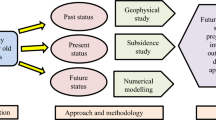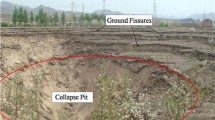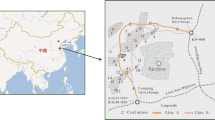Abstract
Ground surface subsidence as the result of the application of caving methods (block caving, sublevel caving and longwall mining) may leave significant impact on surface infrastructures which are located in subsidence influence zone. The Anomaly No. 12 Sechahun located in 32 km from Bafq in Yazd province, Iran was planned to be extracted by sublevel caving method. Evaluating the amount of surface subsidence in this mine was very important because different surface infrastructures (railway, road, natural gas transmission pipeline and water pipeline) and an open pit mine (Anomaly No. 10) are located within the mining area. The main purpose of this research was to evaluate the effect of surface subsidence due to underground iron mine Anomaly No. 12 Sechahun on surface infrastructures through numerical and empirical methods. For this purpose, first, the subsidence parameters such as caving angle, subsidence angle and the influence zone were estimated by empirical methods. Then numerical modeling was applied. To estimate rock mass properties, joint mapping was taken from the site at Anomaly No. 10 and a set of numerical models were employed through a Discrete Fracture Network in 3DEC software to determine representative elemental volume. The FLAC3D software was used to simulate the ground surface subsidence due to sublevel caving method. Then, the longitudinal and transverse profiles of subsidence and the influence zone were studied. The results show that surface infrastructures which are located in subsidence influence zone should be moved to 2–3 km from the orebody deposit center. However, the results of this study still must be validated by engineering monitoring data.





















Similar content being viewed by others
References
Bell FG, Donnelly LJ (2014) Mining and its impact on the environment. CRC Press, Boca Raton
Bonyadi Z, Davidson GJ, Mehrabi B, Meffre S, Ghazban F (2011) Significance of apatite REE depletion and monazite inclusions in the brecciated Se–Chahun iron oxide–apatite deposit, Bafq district, Iran: insights from paragenesis and geochemistry. Chem Geol 281(3–4):253–269
Bozeman MT (2002) Underground hard-rock mining: subsidence and hydrologic environmental impacts. Center for Science in Public Participation
Butcher R, Jenkins PA (2005) Subsidence effects associated with block and sublevel caving of massive orebodies. Australian Centre for Geomechanics Newsletter, vol 25
Cao S, Song W, Deng D, Lei Y, Lan J (2016) Numerical simulation of land subsidence and verification of its character for an iron mine using sublevel caving. Int J Min Sci Technol 26(2):327–332
Chen D, Song W, Cao S (2016) Numerical simulation of land subsidence and its field monitoring using caving method for an iron mine. Electron J Geotech Eng 21:2215–2230
Clark I (2006) Simulation of rock mass strength using ubiquitous joints. Numerical modeling in geomechanics—2006. In: Hart MR, Verona P (eds) Proceedings 4th international FLAC symposium, Paper No. 08–07, Minneapolis, Itasca
Figueroa-Miranda S, Vargas JT, Ramos-Leal JA, Hernández-Madrigal VM, Villaseñor-Reyes CI (2018) Land subsidence by groundwater over-exploitation from aquifers in tectonic valleys of Central Mexico: a review. Eng Geol
Flores G, Karzulovic A (2004) Geotechnical guidelines subsidence. Prepared for International Caving Study, Stage II. JKMRC, Brisbane
GilbrideJ, Free KS, Kehrman R (2005) Modeling block cave subsidence at the Molycorp. Inc, Questa Mine, Alaska Rocks, the 40th US symposium on rock mechanics (USRMS), June 25–29
Helm PR, Davie CT, Glendinning S (2013) Numerical modelling of shallow abandoned mine working subsidence affecting transport infrastructure. Eng Geol 154:6–19
IMPASCO (2009) Detailed exploration report of Anomaly No. 12 Sechahun
Kasmaee S, Torab FM (2014) Risk reduction in Sechahun iron ore deposit by geological boundary modification using multiple indicator Kriging. J Cent South Univ 21(5):2011–2017
Kendorski FS (1978) Cavability of ore deposits. Min Eng 30:628–631
Kratzsch H (2012) Mining subsidence engineering. Springer, Berlin
Laubscher D (2000) Block caving manual. Report for the international caving study. JKMRC and Itasca Consulting Group, Brisbane
Lee S, Park I (2013) Application of decision tree model for the ground subsidence hazard mapping near abandoned underground coal mines. J Environ Manag 127:166–176
Peng SS, Ma WM, Zhong WL (1992) Surface subsidence engineering. Society for Mining, Metallurgy, and Exploration, Littleton
Quanyuan W, Jiewu P, Shanzhong Q, Yiping L, Congcong H, Tingxiang L, Limei H (2009) Impacts of coal mining subsidence on the surface landscape in Longkou city, Shandong Province of China. Environ Earth Sci 59(4):783
Sainsbury B, Pierce M, Mas Ivars D (2008) Analysis of caving behaviour using a synthetic rock mass—ubiquitous joint rock mass modelling technique. South Hemisphere Int Rock Mech Perth 1:343–352
Sengupta M (1993) Environmental impacts of mining monitoring, restoration, and control. CRC Press, Boca Raton
Sharrock G, Vakili A, Duplancic P, Hastings N (2011) Numerical analysis of subsidence for Perseverance Deeps Block Cave in continuum and distinct element numerical modelling in geomechanics, 2011. In: Sainsbury, Hart, Detournay, Nelson (eds) Paper 06-03, Itasca International Inc, Minneapolis (ISBN 978-0-9767577-2-6)
Simeoni U, Tessari U, Corbau C, Tosatto O, Polo P, Teatini P (2017) Impact of land subsidence due to residual gas production on surficial infrastructures: the Dosso degli Angeli field study (Ravenna, Northern Italy). Eng Geol 229:1–12
van As A, Davison J, Moss A (2003) Subsidence definitions for block caving mines. Rio Tinto Technical report, 2003, p 59
Vyazmensky A (2008) Numerical modelling of surface subsidence associated with block cave mining using a finite element/discrete element approach. Doctoral dissertation, Simon Fraser University
Woo Kyu-Seok et al (2013) Empirical investigation and characterization of surface subsidence related to block cave mining. Int J Rock Mech Min Sci 61(31–42):2013
Younger PL, Wolkersdorfer C (2004) Mining impacts on the fresh water environment: technical and managerial guidelines for catchment scale management. Mine Water Environ 23:s2–s80
Author information
Authors and Affiliations
Corresponding author
Additional information
Publisher's Note
Springer Nature remains neutral with regard to jurisdictional claims in published maps and institutional affiliations.
Rights and permissions
About this article
Cite this article
Parmar, H., Yarahmadi Bafghi, A. & Najafi, M. Impact of ground surface subsidence due to underground mining on surface infrastructure: the case of the Anomaly No. 12 Sechahun, Iran. Environ Earth Sci 78, 409 (2019). https://doi.org/10.1007/s12665-019-8424-8
Received:
Accepted:
Published:
DOI: https://doi.org/10.1007/s12665-019-8424-8




